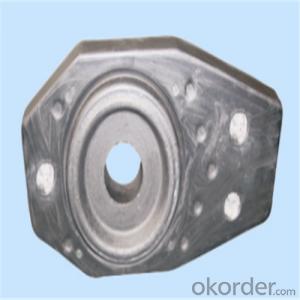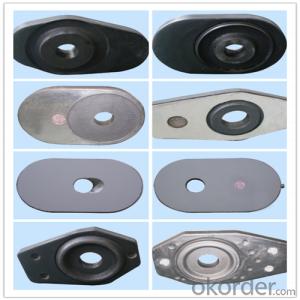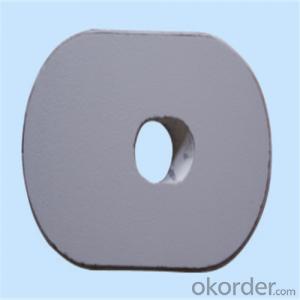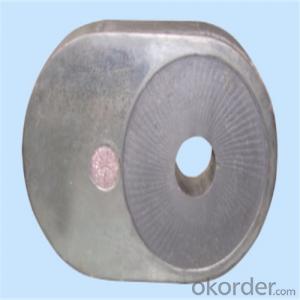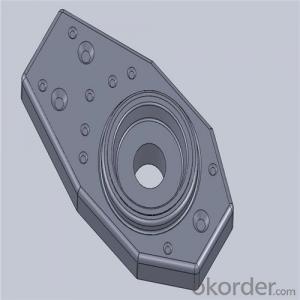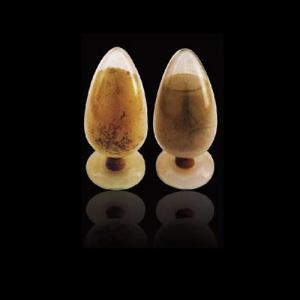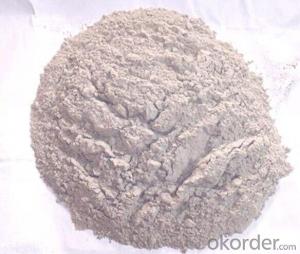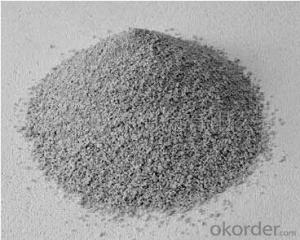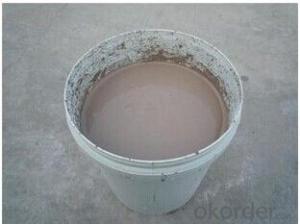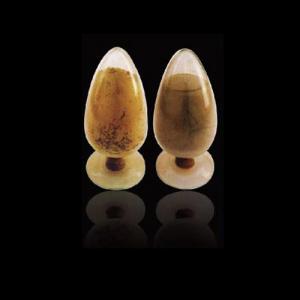High Performance Ladle Slide Gate
- Loading Port:
- Shanghai
- Payment Terms:
- TT OR LC
- Min Order Qty:
- 100 pc
- Supply Capability:
- 1000 pc/month
OKorder Service Pledge
OKorder Financial Service
You Might Also Like
Quick Details for High Performance Refractory Ladle Slide Gate
| Place of Origin: | China (Mainland) | Shape: | Plate | Material: | Alumina Block |
| SiO2 Content (%): | N/A | Al2O3 Content (%): | 80-90% | MgO Content (%): | N/A |
| CaO Content (%): | N/A | Refractoriness (Degree): | 1770°< Refractoriness< 2000° | CrO Content (%): | N/A |
| SiC Content (%): | N/A | Model Number: | CS80 | Brand Name: | |
| Product name: | High performance refractory ladle slide gate | Model No.: | cs80 | Brand name: | CMAX |
| Quality: | Al-C or Al-Zr-C | Service life: | 4-6 heats | Apparent porosity: | 7% Max |
| Bulk density:: | 3.1 MIN | C.C.S: | 120MPA | MOQ: | 100 pcs for trial |
| Delivery time: | 60 working days upon receipt of deposit |
Packaging & Delivery
| Packaging Details: | Inner carton packing, outer wooden case suitable for long term sea shipping |
| Delivery Detail: | three months working days upon receipt of deposit |
Specifications
Surface flatness less than 0.05mm
High mechanical strength
Erosion resistance
Oxidation resistance
Thermal shock stability
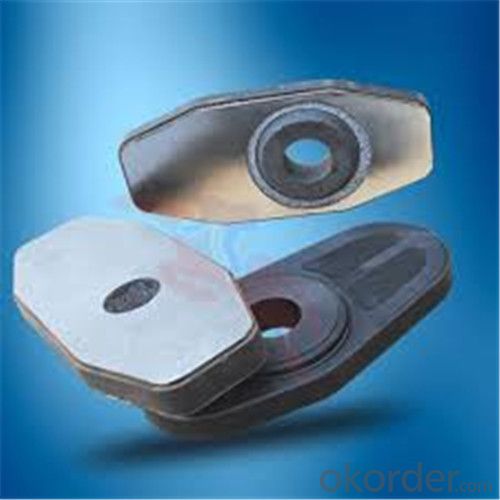
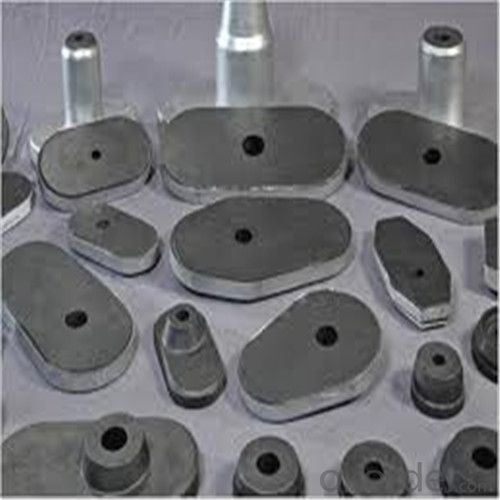
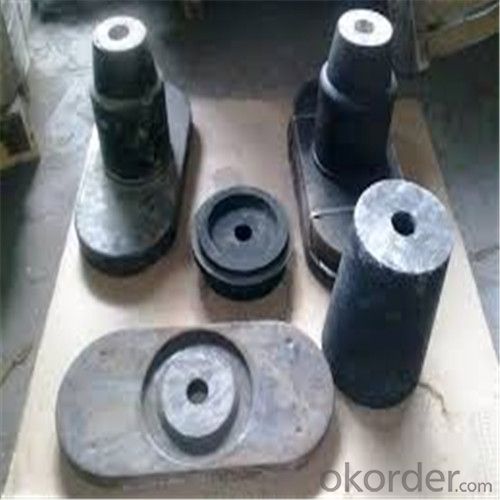
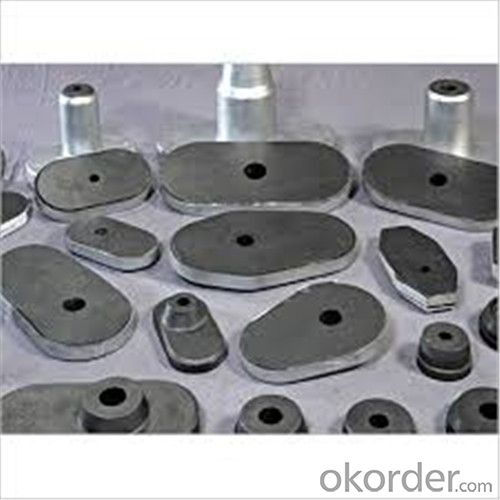


General Chemical Analysis for refractory ladle slide gate :
slide gate plate widely including Alumina carbon and Alumina Zirconia Carbon slide gate plate, MgO and MgO-spinel slide gate plate,nonoxides bonding slide gate plateand unburned slide gate plate.
Alumina -Zirconia-Carbon material
| Al-Zr-C Material | |||||
| Al2O3 | C | ZrO2 | Apparent porosity | Bulk density | C.C.S |
| (% minm) | (% minm) | (% minm) | (% max) | (gm./cc minm) | (MPa minm) |
| 85 | 3 | 5 | 7 | 3.1 | 120 |
| 85 | 3 | 4 | 7 | 3.1 | 120 |
Composite type: Al-Zr-C for working line, outer Al-C material
| Al-Zr-C & Al-C Material | ||||||
| Al2O3 | C | ZrO2 | Apparent porosity | Bulk density | C.C.S | |
| (% minm) | (% minm) | (% minm) | (% max) | (gm./cc minm) | (MPa minm) | |
| Inner side (Working face) | 85 | 3 | 4 | 7 | 3.1 | 120 |
| Outside | 90 | 3 | 0 | 9 | 3 | |
Sample is on your request.
Welcome to visit our factory~
- Q:How do monolithic refractories prevent heat loss through convection?
- Monolithic refractories effectively prevent heat loss through convection due to their unique composition and structure. Unlike traditional refractory bricks, which often have gaps and are porous, monolithic refractories are made of a single, seamless structure. This eliminates any possible pathways for hot gases or air to circulate and carry away heat by convection. Furthermore, monolithic refractories have a high thermal conductivity and are often dense, making them excellent conductors of heat. This allows them to rapidly absorb and distribute heat, minimizing the temperature difference between the hot surface and the surrounding environment. By reducing the temperature gradient, monolithic refractories decrease the driving force for convection, resulting in reduced heat loss through this mechanism. Moreover, monolithic refractories can be applied as a continuous lining, conforming to the shape of the equipment or furnace being protected. This seamless application eliminates joints or gaps where hot gases or air could escape and carry away heat. The uniform and uninterrupted lining further decreases the potential for convection heat loss. In summary, monolithic refractories are specifically designed to create a barrier that hinders the movement of hot gases or air, effectively minimizing heat loss through convection. Their dense composition, high thermal conductivity, and seamless application all contribute to their effectiveness in preventing heat loss through this mechanism.
- Q:How do monolithic refractories withstand the corrosive environments in steelmaking processes?
- Due to their unique properties and composition, monolithic refractories are capable of enduring corrosive conditions in steelmaking processes. The primary feature of monolithic refractories is their exceptional ability to withstand high temperatures and thermal shock. Steelmaking procedures involve extremely high temperatures, which can reach up to 1700 degrees Celsius. Monolithic refractories are specifically engineered to endure these extreme temperatures without compromising their structural integrity. Moreover, monolithic refractories exhibit outstanding chemical resistance. The corrosive environments in steelmaking processes often include aggressive chemicals like molten metal, slag, and gases such as carbon monoxide and sulfur dioxide. Monolithic refractories are manufactured using materials that possess resistance to these chemicals. Consequently, these materials prevent any reactions and consequent corrosion. Furthermore, monolithic refractories possess a compact and uniform structure. This characteristic aids in preventing the infiltration of corrosive agents into the refractory material, further augmenting its resistance to corrosion. The compact structure also minimizes the formation of cracks and fissures, which can serve as pathways for corrosive agents to penetrate the refractory. Additionally, monolithic refractories are frequently composed of materials with high refractoriness, such as alumina, magnesia, and silica. These materials possess high melting points, rendering them more resistant to the extreme temperatures encountered in steelmaking processes. They also possess low thermal conductivity, which assists in reducing heat transfer and lowering the risk of thermal damage to the refractory. Lastly, monolithic refractories are often formulated with specific additives and binders that enhance their resistance to corrosion. These additives may include materials like zircon, chrome, or graphite, which provide supplementary protection against the corrosive environment. In conclusion, monolithic refractories demonstrate their ability to withstand the corrosive environments in steelmaking processes through their high resistance to temperature and thermal shock, excellent chemical resistance, dense and uniform structure, high refractoriness, and the utilization of specialized additives and binders. These attributes make monolithic refractories an optimal choice for enduring the rigorous conditions of steelmaking processes, ensuring the durability and efficiency of the refractory lining.
- Q:How do monolithic refractories withstand high temperatures in iron and steel processing?
- Due to their unique composition and design, monolithic refractories have the capability to endure high temperatures in iron and steel processing. Unlike refractories composed of multiple layers, these refractories are made from a single, solid material, which grants them superior thermal conductivity and resistance to thermal shock. One crucial factor that enables monolithic refractories to withstand high temperatures is their high melting point. Typically composed of materials like alumina, magnesia, silica, or zirconia, these refractories possess melting points that exceed the temperatures encountered in iron and steel processing. This ensures that the refractories do not deteriorate or melt when exposed to such extreme temperatures. Additionally, monolithic refractories exhibit excellent thermal insulation properties. With low thermal conductivity, they effectively impede heat transfer from the hot molten metal or gases to the surrounding environment. This insulation property helps sustain high temperatures within the processing units, ensuring efficient and effective iron and steel production. Another significant aspect contributing to the ability of monolithic refractories to withstand high temperatures is their resistance to thermal shock. In iron and steel processing, rapid temperature changes are frequent, which can lead to cracking or spalling in traditional refractories. However, monolithic refractories possess a more homogeneous structure and greater flexibility, enabling them to endure these sudden temperature fluctuations without significant damage. Apart from their composition, the installation method of monolithic refractories also plays a role in their ability to withstand high temperatures. Typically, these refractories are installed using a technique called gunning or shotcreting, where a mixture of refractory material and water is sprayed onto the surface, forming a dense and solid lining. This installation method ensures a strong bond between the refractory and the substrate, enhancing the overall strength and durability of the lining. Overall, monolithic refractories can withstand high temperatures in iron and steel processing due to their high melting point, excellent thermal insulation properties, resistance to thermal shock, and proper installation techniques. These refractories are essential in maintaining the integrity and efficiency of the processing units, facilitating the production of high-quality iron and steel products.
- Q:How are monolithic refractories installed and repaired in iron and steel plants?
- Monolithic refractories in iron and steel plants are typically installed through a process called gunning, where a specialized gunning machine is used to spray the refractory material onto the desired surface. The refractory material is mixed with water or a bonding agent to form a dense and durable lining. In terms of repairs, damaged or worn-out monolithic refractories are typically removed by mechanical means, such as jackhammers or pneumatic tools. The damaged area is then cleaned and prepared before new refractory material is applied using the gunning method. In some cases, patching materials may be used to repair smaller areas of damage. Overall, the installation and repair of monolithic refractories in iron and steel plants require skilled technicians and specialized equipment to ensure the optimum performance and longevity of the refractory lining.
- Q:What are the challenges in recycling and disposing of monolithic refractories?
- Recycling and disposing of monolithic refractories pose several challenges that need to be addressed in order to minimize environmental impact and maximize resource efficiency. One of the main challenges is the handling and transportation of monolithic refractories due to their heavy and bulky nature. These materials are often used in high-temperature applications, such as furnace linings, and can be difficult to dismantle and remove from equipment. The weight and size of monolithic refractories make it challenging to transport them to recycling or disposal facilities, requiring specialized equipment and infrastructure. Another challenge is the heterogeneity of monolithic refractories, which often contain various types of refractory materials, binders, and additives. This complexity makes it difficult to separate and categorize different components for effective recycling. The lack of standardized recycling processes for monolithic refractories further complicates the recycling efforts. Furthermore, the high melting points of refractory materials used in monolithic refractories can make it energy-intensive and costly to recycle them through conventional methods like melting and remolding. Alternative recycling methods, such as thermal treatment or chemical processing, need to be explored and optimized to make the recycling process more economically and environmentally viable. Ensuring the proper disposal of monolithic refractories is also a challenge. If these materials are not recycled, they often end up in landfills, taking up valuable space and potentially leaching harmful substances into the environment. Landfilling refractories can also pose a risk of contamination if they are not properly managed or if hazardous additives are present in the materials. To address these challenges, it is crucial to invest in research and development to develop more efficient and cost-effective recycling technologies for monolithic refractories. Collaboration between manufacturers, recycling facilities, and regulatory bodies is also essential to establish guidelines and standards for the recycling and disposal of these materials. Additionally, educating industries and end-users about the importance of recycling and the availability of recycling options can help increase the demand and feasibility of recycling monolithic refractories.
- Q:How do monolithic refractories withstand high temperatures and thermal shocks?
- Monolithic refractories are able to withstand high temperatures and thermal shocks due to their unique composition and design. These refractories are made from a single piece or structure, hence the term "monolithic". This structural integrity allows them to resist the extreme heat and sudden temperature changes experienced in high-temperature applications. One key factor that enables monolithic refractories to withstand high temperatures is the use of high-quality raw materials. These materials are carefully selected for their ability to withstand heat and thermal stress. Common components include silica, alumina, magnesia, and other refractory minerals with high melting points. Additionally, the manufacturing process plays a crucial role in enhancing the thermal resistance of monolithic refractories. The raw materials are mixed with binders, such as clay or cement, to form a homogenous mixture. This mixture is then shaped and installed in its final position, either by pouring or gunning, depending on the application. The binder ensures that the refractory maintains its shape and integrity during thermal cycling. Furthermore, monolithic refractories possess excellent thermal conductivity and low thermal expansion properties. This means that they can efficiently transfer and dissipate heat, minimizing the risk of thermal stress and cracking. The low thermal expansion also reduces the likelihood of spalling or delamination, which is crucial for withstanding thermal shocks. Another factor contributing to the high-temperature resistance of monolithic refractories is their ability to form a protective layer or slag at the surface. This layer acts as a barrier, preventing the refractory from direct contact with corrosive materials or aggressive atmospheres. It helps to improve the refractory's longevity and resistance to thermal shocks. Overall, the combination of high-quality raw materials, careful manufacturing techniques, and beneficial thermal properties enables monolithic refractories to withstand high temperatures and thermal shocks. These refractories are widely used in various industries, including steel, cement, glass, and petrochemical, where they serve as reliable linings in furnaces, kilns, and other high-temperature equipment.
- Q:What are the main factors affecting the abrasion resistance of monolithic refractories?
- The main factors affecting the abrasion resistance of monolithic refractories are the composition of the refractory material, the size and shape of the abrasive particles, the velocity and angle of impact of the abrasives, and the temperature and pressure conditions in the application environment.
- Q:How are monolithic refractories different from traditional refractories?
- Monolithic refractories are different from traditional refractories in terms of their composition, installation method, and performance characteristics. Firstly, monolithic refractories are composed of a single material, as the name suggests, whereas traditional refractories are typically made up of multiple materials. This single material composition of monolithic refractories allows for better control over their properties and performance. Secondly, the installation of monolithic refractories is different from traditional refractories. Traditional refractories are usually installed in the form of bricks or precast shapes, which are assembled together to form the desired lining. On the other hand, monolithic refractories are supplied in a ready-to-use form, such as a dry mix or a suspension, which is then poured, sprayed, or gunned into place. This makes the installation process of monolithic refractories faster and more efficient. Lastly, monolithic refractories offer superior performance characteristics compared to traditional refractories. Monolithic refractories have better thermal shock resistance, higher hot strength, and improved resistance to chemical attacks. Additionally, they can be more easily repaired or patched compared to traditional refractories, which often require the replacement of entire bricks or shapes. Overall, the main differences between monolithic refractories and traditional refractories lie in their composition, installation method, and performance characteristics. Monolithic refractories offer better control over properties, easier installation, and superior performance, making them a preferred choice in many industrial applications.
- Q:What are the key trends in the use of monolithic refractories in the iron and steel industry?
- It is worth noting that there are several notable trends in the use of monolithic refractories in the iron and steel industry. First and foremost, there is an increasing demand for monolithic refractories due to their superior performance characteristics in comparison to traditional brick refractories. Monolithic refractories provide higher thermal shock resistance, superior insulation properties, and improved resistance to chemical attacks. As a result, they are being used more extensively in various applications within the iron and steel industry. Secondly, there is a shift towards the utilization of low-cement and ultra-low cement castables in monolithic refractories. These materials contain a reduced amount of cement, leading to enhanced refractory properties such as increased strength, better corrosion resistance, and improved resistance to thermal spalling. This trend is driven by the need to enhance the overall efficiency and longevity of refractory linings in iron and steel manufacturing processes. Another significant trend is the development of advanced monolithic refractories that prioritize sustainability and environmental performance. The iron and steel industry is facing mounting pressure to reduce its carbon footprint and minimize its impact on the environment. Consequently, there is a growing emphasis on the use of environmentally friendly binders and additives in monolithic refractories. These novel materials not only offer excellent refractory properties but also contribute to the industry's sustainability objectives. Moreover, there is an increasing focus on the development of monolithic refractories capable of withstanding extreme operating conditions. Iron and steel manufacturing processes involve high temperatures, aggressive chemical environments, and severe mechanical stresses. Consequently, there is a need for monolithic refractories that can withstand these harsh conditions without compromising their performance. The industry is investing in research and development to create refractories that exhibit exceptional resistance to thermal shock, abrasion, and erosion. Lastly, there is a growing adoption of digital and smart technologies for the monitoring and maintenance of monolithic refractories. Advances in sensor technology and data analytics have made it possible to collect real-time data on the condition and performance of refractory linings. This enables proactive maintenance, early detection of potential issues, and optimization of refractory usage, ultimately leading to improved operational efficiency and cost savings. In conclusion, the use of monolithic refractories in the iron and steel industry is witnessing key trends such as the demand for superior performance, the shift towards low-cement and ultra-low cement castables, the development of sustainable materials, the focus on extreme operating conditions, and the adoption of digital and smart technologies for monitoring and maintenance. These trends reflect the industry's continuous efforts to enhance the efficiency, durability, and environmental sustainability of refractory linings in iron and steel manufacturing processes.
- Q:How are monolithic refractories recycled or disposed of at the end of their lifespan?
- Monolithic refractories, widely utilized in high-temperature industrial applications, offer various means of recycling or disposal once their lifespan concludes. The preferred approach depends on the specific monolithic refractory type and its composition. Reclamation stands as a common method for recycling monolithic refractories. This process entails collecting used refractory materials and subjecting them to processing to eliminate any impurities or contaminants. The resultant reclaimed refractory material can then be crushed, ground, or milled into a fine powder suitable for utilization as a raw material in manufacturing new refractories. Thermal treatment represents an alternative means of recycling monolithic refractories. This method involves exposing the used refractory material to high temperatures within a controlled environment, such as a kiln or furnace. The heat effectively breaks down the refractory material, eliminating any binders or impurities. The resulting material can then be reused as a raw material or integrated into other applications, such as construction aggregates. When recycling is not feasible, specialized facilities designed for handling and treating hazardous waste offer a disposal avenue for monolithic refractories. These facilities ensure the proper containment and treatment of the refractory material, minimizing any potential environmental impact. This disposal method is typically reserved for refractories containing hazardous substances or those that cannot be recycled due to their composition. It is important to emphasize that the appropriate disposal or recycling method for monolithic refractories must adhere to local regulations and guidelines. These regulations aim to ensure the safe handling, treatment, and disposal of these materials, taking into account their potential environmental and health effects. Therefore, industries and businesses must collaborate closely with waste management professionals and adhere to the appropriate procedures to responsibly manage monolithic refractories at the end of their lifespan.
1. Manufacturer Overview |
|
|---|---|
| Location | |
| Year Established | |
| Annual Output Value | |
| Main Markets | |
| Company Certifications | |
2. Manufacturer Certificates |
|
|---|---|
| a) Certification Name | |
| Range | |
| Reference | |
| Validity Period | |
3. Manufacturer Capability |
|
|---|---|
| a)Trade Capacity | |
| Nearest Port | |
| Export Percentage | |
| No.of Employees in Trade Department | |
| Language Spoken: | |
| b)Factory Information | |
| Factory Size: | |
| No. of Production Lines | |
| Contract Manufacturing | |
| Product Price Range | |
Send your message to us
High Performance Ladle Slide Gate
- Loading Port:
- Shanghai
- Payment Terms:
- TT OR LC
- Min Order Qty:
- 100 pc
- Supply Capability:
- 1000 pc/month
OKorder Service Pledge
OKorder Financial Service
Similar products
New products
Hot products
Related keywords
